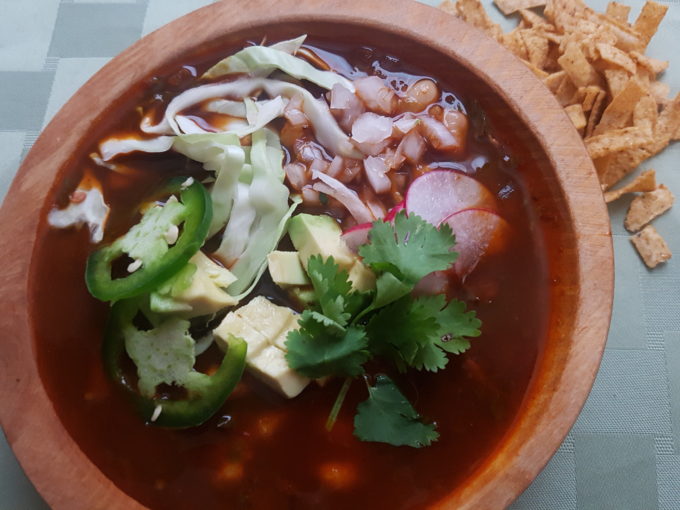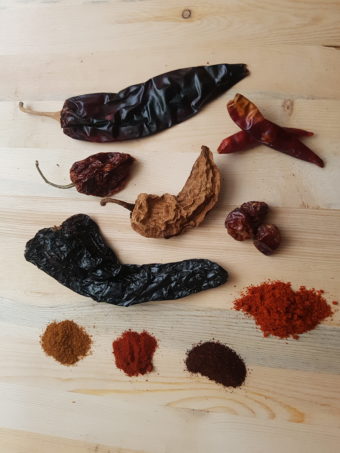

Dried Chilies, from top down: Gaujillo, 2 Japones, Habanero, Chipotle, Dundicuts (from Pakistan), a Large Ancho. Ground chilies from left to right: Cayenne, Smoked Paprika, Pasilla, de Arbol.
Now, I am by no means a vegetarian, however I am a very happy ‘meat-on-the-side’ eater and love all manner of vegetarian proteins. One of the most fascinating things about world cuisine is how many people, (a majority of the world population actually) eat little to no meat on a regular basis. This does not however mean that their food is bland!
In fact, without having to rely on the overwhelmingly pleasant flavor of roasted fat itself, not to mention the delight of a good smokey piece of flame cooked meat, it does tend to lead one into more creative seasoning ideas for a dish.
South East Asian is out outstandingly known for this, as is Indian cuisine. But it may come as a surprise that Mexico too, known in America for all things ground beef, really is traditionally fed on corn, chilies, papitos, and beans. Pozole is just that! The corn of choice is hominy, and the papitos are roasted, but what of the chilies? Well may I offer some suggestions:
A word about dried chilies…
Obviously every dried chili has to have come from a fresh chili at some point. Interestingly they often change the name between the two. The choice for use of chilies in both the green and red pozole sauces is completely up to the chefs, however, the dried chilies sure can pack the heat. I’ll lay out a few of the most common chilies here, from lease heat to most:
California Chilies are Dried Anaheims (AKA New Mexico or Hatch)- These can be quite mild, but every few might have an unexpected bite. Enchilada sauce is most commonly made using these chilies.
Ancho Chilies are Dried Pablanos – Obviously they have more heat than a bell pepper, but they really are not considered spicy. This is what is use in chili rellenos. Cooking for your children or grandma? This might be a good choice. They have an earthy and sweet flavor.
Pasilla Chilies are Dried Chilaco or Chile Negro – These are mild to medium in heat with rich flavor.
Guajillo Chilies are Dried Mirasol Chilies – They are of medium heat. I, personally, never seen these fresh.
De Arbol Chilies are Simply Dried De Arbol – These are substantially more spicy than the previous on this list, but adding a portion to your soup is fantastic.
Crushed Red Peppers are usually Dried Cayenne – You may think, “I’ll just use what I have on hand.” You don’t want to do that. You may, however want to add a little if your really want hot soup!
Others:
Chipotles are Smoked Jalapenos – These can be ‘fresh’ in a can or dried. Jalapenos, despite their reputation, are really not that hot on the scale of chilies, however, smoking them brings a very unique flavor that many people really like. You may choose to add them to your soup for this reason.
Chili Powder – This is ground mix that usually includes not only several different kinds of chilies, but also additional spices such as cumin, oregano, and garlic. I suppose you could use chili powder to make your pozole if you really needed to, but I wouldn’t suggest it. It might end up tasting like the watery run-off of a generic can of chili beans.
Paprika – Chilies truly are native to the Americas, however Paprika comes from a particular species that has been adapted to Europe through trade. It is associated with Spain, but most commonly Hungarian cuisine, and comes in many varieties. It is particularly known for being less hot than other chili peppers, but within that standard there are regular, smoked, and ‘sweet‘ grades. The sweet paprika has had the spicy seeds removed before being ground. Paprika might make a decent back-up plan if other, more traditional chilies, are not available.
Once you have picked your chilies the final decision of what type of bean to use is much easier. I usually suggest a white bean for pozole verde, but with the rich red sauce of pozole rojo, you could very well get away with red or black beans. Try ayocote, cannelloni, or navy beans otherwise.
Lastly, be sure to provide a generous amount of the garnishes. The avocado is an absolute must. The creaminess, added protein, and fat contend perfectly with the heat of the chilies.
Vegetarian Pozole Rojo
By:semiserious chefs
Serves: 6
Ingredients:
- 2 15 oz cans of precooked beans – drained if preferred
- OR 1 pound dried beans cooked as directed on package
- 4 cups vegetable stock
- 4 cups water
- 6 garlic cloves – minced
- 2 bay leaves
- 1 T oregano (Mexican preferred)
- 1/2 T cumin
- 1 onion – diced
- 2 28oz cans of hominy
- 4 oz (1 cup) mixed ground Chilies*
- See the list above to create your own combination
- OR 2 ancho chilies, 3 guajillo chilies, 1 T ground de Arbol chili, 1 T pasilla chilies
*To grind your own chilies, break off the stems, split and shake out the seeds. I imagine you could grind them dry, but the most common way is to soak them in water for 30 minutes then grind them into a puree when they are soft. You can use some of the broth for this as you need.
Note: When cooked traditionally using meat, there can be quite a bit of fat. A splash of your preferred vegetarian oil with each serving might increase the flavor of this dish.
Garnishes:
- avocado – cubed small
- red radish – sliced thin and halved
- white onion – diced small
- jalapenos – thin sliced or fine diced
- fresh cilantro – chopped
- cabbage or iceberg lettuce – sliced into thin strips
- lime wedges
- tortilla strips
Directions:
- If using dried beans pre-soak and cook them as directed. If using canned beans, drain them.
- Grind your chilies as needed using some of the broth or water, then add them, the rest of the broth and water, the beans, minced garlic, bay leaves, cumin, oregano, diced onions, and hominy to a large pot with a lid and bring to a firm boil for 15-20 minutes.
- While your soup cooks, prep your garnishes of choice.
- Serve a hearty helping of soup to each guest with a large plate of garnishes in the center of the table, allowing each person to top their own soup as desired.


Post a comment